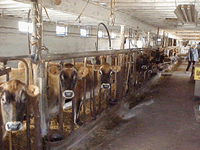Over the past decade, New Jersey witnessed more than half its dairy farms go out of business. Today, the number of dairy farms statewide totals approximately 140. Farmers' decisions to abandon dairy farming are largely attributable to the high cost of doing business, coupled with volatile pricing in the federal milk marketing system, which results in low profits. Though the number of farms has rapidly decreased, milk production has declined at a slower rate due to herd expansion and improved dairy herd production and management. New Jersey's milk production in 2001 totaled 233 million lbs. valued at $37.5 million. Milk production in 1991 totaled 349 million lbs. valued at $54 million.
Beyond ensuring a dairy payment system for producers, processors and marketers, the New Jersey Department of Agriculture is working to expand the New Jersey Cattle Health Assurance Program (NJCHAP). The program aims to improve herd health and production quality through herd management practices and disease testing. The Department also supports implementation of the Garden State re-engineering initiative, which works toward improving the economic conditions for dairy farmers by addressing milk quality, nutrient management and financial management.
In keeping with the goals outlined in its strategic plan, the Department continues to identify strategies to ensure the economic viability of the state's dairy industry as well as the agricultural industry as a whole.
STRATEGIES
- Support Re-establishment and Expansion of the Northeast Dairy Compact
- Examine different price support systems, including Compacts. When the New England states operated under a Dairy Compact pricing system, on-farm milk prices were stabilized, resulting in a dramatic slow-down in the number of dairy farms lost in that region. The Compact disbanded in September 2001 due to the lack of Congressional consent. A federal Milk Income Loss Contract (MILC) payment system was established under the 2002 Farm Bill, but is limited to three years and does not cover 46 percent of the state's production due to the annual fiscal year 2.4 million lb. cap.
- Examine different price support systems, including Compacts. When the New England states operated under a Dairy Compact pricing system, on-farm milk prices were stabilized, resulting in a dramatic slow-down in the number of dairy farms lost in that region. The Compact disbanded in September 2001 due to the lack of Congressional consent. A federal Milk Income Loss Contract (MILC) payment system was established under the 2002 Farm Bill, but is limited to three years and does not cover 46 percent of the state's production due to the annual fiscal year 2.4 million lb. cap.
- Increase Demand for Milk
- Explore the concept of marketing flavored milk in New Jersey's schools.
- Seek to brand New Jersey produced milk by including milk in the Jersey Fresh marketing program and developing a logo.
- Promote the nutritional benefits of drinking milk at a young age.
- Support the American Dairy Association in repositioning milk in retail markets, making it more attractive to consumers.
- Work closely with the Departments of Agriculture in the Northeast states to collaborate on mutual marketing efforts.
- Explore the concept of marketing flavored milk in New Jersey's schools.
- Assist in Minimizing Input Costs
- Help facilitate the use of renewable energy sources to lower input costs and improve profitability.
- Promote the availability of grants and cost-share opportunities for conservation activities that would help protect the environment and improve profitability.
- Help facilitate the use of renewable energy sources to lower input costs and improve profitability.
- Ensure Quality Production and Food Safety
- Continue working to protect the health of the dairy industry from the threat of devastating and economically damaging diseases. This includes quarterly monitoring for Brucellosis, monitoring for tuberculosis on all suspect cows, providing dairy farmers with bio-security disease control as requested and providing free whole herd blood testing for Johne's Disease.
- Continue working with Rutgers and NJ Farm Bureau in helping New Jersey Dairy farmers utilize the FIN Pak Program, a software program that promotes good business practices through financial management analyses.
- Continue working to protect the health of the dairy industry from the threat of devastating and economically damaging diseases. This includes quarterly monitoring for Brucellosis, monitoring for tuberculosis on all suspect cows, providing dairy farmers with bio-security disease control as requested and providing free whole herd blood testing for Johne's Disease.
- Assist in Addressing Labor Issues
- Continue the commitment to programs that support worker training, keep workers healthy and safe, and address issues such as farm labor housing.
- Support reform of policies and procedures addressing temporary agricultural worker visas at the federal and state level.
- Encourage farmers to take a pro-active approach to learning about their responsibilities at both the federal and state levels to ensure worker safety.
- Continue the commitment to programs that support worker training, keep workers healthy and safe, and address issues such as farm labor housing.



